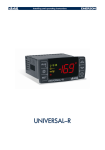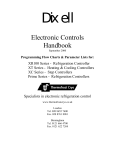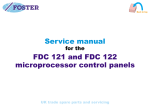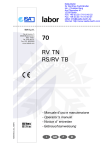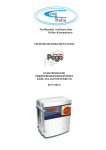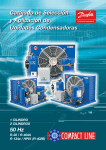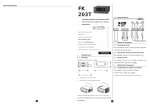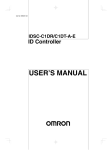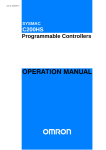Download Emerson Universal-R Technical data
Transcript
Instructions Manual cod. 1592001121 81,9(56$/²59 NEW FEATURES on the V3.0 • HEATING : As well as cooling, the Universal-R can now be used to control heating applications up to +105c, using the NTC probes supplied in box. For temperatures above 105c and up to maximum +150c, please order special PTC probe (S6.SH), Part No. DIXL957 • AUTOMATIC PROBE REGOGNITION:The Universal-R can work with either NTC or PTC probes. It can now automatically recognise which type of probe is connected and set itself accordingly. During auto probe recognition, probe temperature must be Min. –50c, Max. + 60c • PROBES SUPPLIED AS STANDARD: The Universal-R is now supplied with 2 of the latest fully encapsulated NTC probes • HOT KEY PROGRAMMING:You can now use a “Hot Key” (Part No. DIXL695) to transfer parameter settings between one Universal-R and another (V3.0 only) • DIGITAL INPUT: The Universal-R now has a digital input that you can configure to accept external signals, i.e. - door switch, pressure switch, alarms, energy saving etc. (9(1 025( )/(;,%,/,7< 025( &219(1,(1&( 7+( 81,9(56$/5 &$1 12: 5(3/$&( :(// 29(5 27+(5 &21752//(56 1. Instructions Manual cod. 1592001121 INDEX 1. INDEX_________________________________________________________________________________2 2. GENERAL WARNING ____________________________________________________________________3 3. GENERAL DESCRIPTION _________________________________________________________________3 4. QUICK START UP PROCEDURE – Up and running in 6 easy steps_________________________________4 TYPICAL CONNECTIONS - FOR GENERAL GUIDANCE ONLY _______________________________________5 6. PARAMETER TABLE and factory default settings _______________________________________________6 7. SERVICE REPLACEMENT - MODELS AND PROBE INFORMATION _______________________________7 8. PARAMETERS – THEIR FUNCTIONS IN DETAIL_______________________________________________9 9. BUTTONS – WHAT ARE THEIR FUNCTIONS ________________________________________________11 10. PROGRAMMING MODE _________________________________________________________________11 11. OTHER FEATURES OF THE UNIVERSAL-R _________________________________________________12 12. THERMOSTAT OVERRIDE ( not available when parameter “tC” = 1 or 6 ) ___________________________12 13. DEFROST TYPES ______________________________________________________________________12 14. EVAPORATOR FAN CONTROL ( only when parameter “tC” = 5 )__________________________________12 15. SPECIAL APPLICATIONS – TWIN COMPRESSOR – DEAD BAND CONTROL_______________________13 16. ALARMS______________________________________________________________________________13 17. REMOVING SECURITY CODE PROTECTION ________________________________________________14 18. MOUNTING ___________________________________________________________________________14 19. ELECTRICAL CONNECTIONS ____________________________________________________________14 20. PROBES______________________________________________________________________________14 21. TECHNICAL DATA______________________________________________________________________14 22. FAULT FINDING_______________________________________________________________________15 1592001121 Universal-R3 GB 19.11.2004.doc rel. 1.0 Pa. 2 / 15 Instructions Manual cod. 1592001121 2. GENERAL WARNING WARNING: The Universal-R should always be installed by a suitabley qualified person, in accordance with best electrical and refrigeration practice. Take time to read the instructions. Do not exceed the relay ratings. The Universal-R should not be considered a safety device, use suitable safety cutout devices when appropriate. • • • This manual is part of the product and should be kept near the instrument for easy and quick reference. The instrument shall not be used for purposes different from those described hereunder. It cannot be used as a safety device. Check the application limits before proceeding. 2.1 SAFETY PRECAUTIONS • • • • • • • • • • Check the supply voltage is correct before connecting the instrument. Do not expose to water or moisture: use the controller only within the operating limits avoiding sudden temperature changes with high atmospheric humidity to prevent formation of condensation Warning : Disconnect all electrical connections before any kind of maintenance. The instrument must not be opened. Fit the probe where it is not accessible by the End User. In case of failure or faulty operation send the instrument back to the distributor with a detailed description of the fault. Do not exceed the maximum current that can be applied to each relay (see Technical Data). Ensure that the wires for probes, electrical loads and the power supply are separated and far enough from each other, without crossing or intertwining. In case of applications in industrial environments, the use of mains filters (our mod. DIXL930) in parallel with inductive loads could be useful. Heating applications – Do not exceed 105c with the NTC probes supplied. For higher temperatures (up to a maximum of 150c) use special PTC probes - our Part No. DIXL957. 3. GENERAL DESCRIPTION Model Universal-R is a 32x74 mm format microprocessor based controller suitable for applications on high, medium or low temperature refrigeration units. It is provided with three relay outputs to control compressor, defrost - which can be either electrical or hot gas - and evaporator fans. It can work with PTC or NTC probes. Where defrost is being terminated by time, it can operate with just one thermostat probe or where defrost is being terminated by temperature, it has an input for a second (evaporator) probe. The Universal-R is equipped with an internal alarm buzzer, a flashing visual alarm as well as a 4th relay ( volt free ) that can be configured as Auxiliary, Alarm or to control a heater in Dead Band control (see parameter oAc) Each instrument is fully configurable through special parameters that can be easily programmed through the keypad. 1592001121 Universal-R3 GB 19.11.2004.doc rel. 1.0 Pa. 3 / 15 4. Instructions Manual cod. 1592001121 QUICK START UP PROCEDURE – Up and running in 6 easy steps This Quick Start Up section is designed to get you up and running with the minimum of fuss. Just follow these 6 simple steps. STEP 1 - Using the table below, decide which type of controller you wish the Universal-R to function as and take note of the required setting for parameter “tC” Also take note of the number of probes to be connected. Type of Control Number Paramete of probes r “tC” required setting 1 x1 On / Off thermostat – Cooling 2 x1 Off cycle defrost (timed) 3 x1 Electrical / Hot Gas defrost, time initiated / time terminated 4 x2 Electrical / Hot Gas defrost, time initiated / temperature terminated 5 x2 Electrical / Hot Gas defrost, time initiated / temperature terminated + evap. fan delay 6 x1 On / Off thermostat – Heating Note: “tC” settings 3, 4 & 5, default to Electrical Defrost. Hot Gas is possible by setting parameter “tdF” for gas defrost. Settings 1,2,3 & 6 do not require the 2nd probe to be fitted Ð STEP 2 - Install the new Universal-R and connect up the wiring and probe(s). If in doubt, refer to Section on typical wiring connections Ð STEP 3 - Turn on the power supply to the controller For 1 minute, you now have direct access (without pass code) to parameter “tC” and to start the automatic probe type recognition, after which these parameter settings will have to be done manually and the pass code will have to be entered. Ð STEP 4 - Within 1 minute from the power on, press the n button for 3 seconds, the controller will automatically recognise if the probes connected to it are PTC or NTC. During recognition time the controller will display: tPd (type of probe detection) followed by the kind of probe “ntc” or “Ptc” flashing for few seconds. Notes: Probe temperature must be between –50c & + 60c for automatic probe recognition to work correctly When using 2 x probes, both must be the same type, you cannot mix them. Ð STEP 5 – Within 1 minute from the power on, press the “SET + n ” buttons for 3 seconds and the label “Pr2” will be shown, release the buttons and parameter “tC” will be displayed, then press the “SET” button again to see the current setting and adjust using the o & n buttons to the setting you require for your particular application. Allow display to return to normal Ð STEP 6 - Press the “SET” button for 3 seconds until the small LED’s at the top of the display start to flash and the Set Point value is displayed, then adjust the “Set Point” using the o & n buttons. IMPORTANT: Finally turn off the power then turn back on again Ð We recommend you you check the parameter default settings listed in these instructions to ensure they suit your particular application. If you need to make further parameter adjustments or you require more information, read the following sections 1592001121 Universal-R3 GB 19.11.2004.doc rel. 1.0 Pa. 4 / 15 5. Instructions Manual cod. 1592001121 TYPICAL CONNECTIONS - FOR GENERAL GUIDANCE ONLY Parameter tC = 1, 2 or 6 Parameter tC = 3 On / Off thermostat or Off Cycle Defrost Controller Forced defrost controller, time initiated & time terminated Line 8(3)A250V Max 10A 8(3)A a 8(3)A 8(3)A a 8(3)A 8(3)A250V Max 10A 8(3)A R oo m R oo m probe Line Not used Alarm/ Line N.C . Compr. AUX or liquid Not used line valve (or Heater when tC=6) N.C . Alarm/ Line N.C . AUX Comp Def 8(3)A Not used Parameter tC = 5 Forced defrost controller, time initiated & temperature terminated with evaporator fan delay after defrost Comp Alarm/ Line N.C . AUX 8(3)A250V Max 10A a R oo m 8(3)A Def N.C . 8(3)A 8(3)A Line E va p. 8(3)A a 8(3)A 8(3)A250V Max 10A R oo m E va p. Parameter tC = 4 Forced defrost controller, time initiated & temperature terminated Line N.C . Def Fan Comp 8(3)A Alarm/ Line N.C . AUX Not used 1592001121 Universal-R3 GB 19.11.2004.doc rel. 1.0 Pa. 5 / 15 Instructions Manual cod. 1592001120 6. PARAMETER TABLE and factory default settings IMPORTANT : Always set parameter “tC” first. As you move “tC” between settings 1 to 5, all non- relevant parameters will become masked out. Once “tC” has been set correctly, you can then alter any other parameter if you need to. WARNING!! Always switch the power OFF then ON at the end of programming to initiate changes. If parameter “tC” is set to 4 or 5 without an evaporator probe fitted, a P2 probe alarm will be generated. If you do intend to use settings 4 or 5 fit a probe, if you intend to use settings 1, 2 or 3, you must switch the power OFF then ON again to clear the alarm. UNIVERSAL R Type (category) of controller Label tC Adjustment Range 1 = On / Off Thermostat Factory defaults with parameter “tC” 1- 6 1 2 = Off cycle defrost 2 3 = Time / time defrost 3 4 = Time / temp defrost 4 5 = Time / temp defrost + fan delay 5 6 = On / Off Thermostat for heating Probe type PbC Differential 6 1 1 1 1 1 1 HY 0 = PTC 1 = NTC 0.2 ÷ 30.0 °c 2.0 2.0 2.0 2.0 2.0 2.0 Minimum Set Point limit LS - 50 °c ÷ Set Point -50.0 -50.0 -50.0 -50.0 -50.0 -50.0 Maximum Set Point limit US Set Point ÷ 150 °c 50.0 50.0 50.0 50.0 50.0 50.0 Anti-short cycle delay AC 0 ÷ 30 mins. 1 1 1 1 1 1 Temperature alarm configuration ALC 1 1 1 1 1 High temperature alarm ALU 50 50 50 50 50 Low temperature alarm ALL - 50 - 50 - 50 - 50 - 50 Temperature alarm delay Delay of temperature alarm at start up Outputs activation delay at start up Thermostat override Defrost delay after thermostat override Interval between defrosts Delay start of defrost ( Maximum ) duration of defrost Defrost termination temperature Display during defrost ALd dAO OdS CCT dAF IdF dSd MdF dtE dFd 15 90 0 15 90 0 0 2 4 0 15 15 90 0 0 2 6 0 15 15 90 0 0 2 6 0 30 8.0 15 90 0 0 2 6 0 30 8.0 3 3 3 3 10 10 10 10 0 0 0 0 0 2 1 1 1 Defrost display time out dAd Defrost type ( forced ) tdF Drain down time Fdt First defrost after power on dPO Evaporator fan operating mode FnC Evaporator fan stop temperature Evaporator fan delay after defrost FSt Fnd 0 = Relative to SP 1 = Absolute 0 ÷ 50 °c (Relative) ALL÷150 °c (Absolute) 0 ÷ 50 °c (Relative) - 50 °c ÷ ALU (Absolute) 0 ÷ 250 mins. 0 ÷ 720 mins. 0 ÷ 250 mins. 0 ÷ 990 mins. 0 ÷ 250 mins. 1 ÷ 250 hours 0 ÷ 59 mins. 0 ÷ 250 mins. - 50 ÷ 150 °c 0 = Real temp. 1 = Temp. at defrost start 2 = Set Point 3 = “DEF” label 4 = “DEG” label 0 ÷ 250 mins. 0 = Electrical 1 = Hot Gas 0 ÷ 60 mins. 0 = Immediate 1 = After normal interval 0÷4 ( 1 = Fan always on apart from during defrost. See section 10 for info. on other settings ) - 50 ÷ 150 °c 0 ÷ 250 mins. 1592001121 Universal-R3 GB 19.11.2004.doc 1 1 25 7 rel. 1.0 Pa. 6 / 15 1 50 - 50 15 90 0 Instructions Manual UNIVERSAL R Thermostat probe calibration Evaporator probe calibration Display Resolution Label Adjustment Range Ot OE rES 0.0 0.0 0.0 0.0 0.0 0.0 0.0 0 0 0 0 0 0 0 0 0 0 15 15 15 15 15 15 30 30 30 30 30 30 1 1 1 1 1 1 5 5 5 5 5 5 0 0 0 0 0 0 0 0 0 0 0 0 0 0 0 0 0 0 0 0 0 0 0 0 Compressor ON time with faulty probe COn - 12.0 ÷ 12.0 °c - 12.0 ÷ 12.0 °c 0 = With decimal point 1 = No decimal point 0 = ° Celsius 1 = ° Fahrenheit 0 ÷ 250 mins. Compressor OFF time with faulty probe COF 0 ÷ 250 mins. tbA Temperature measurement unit (°C/°F) cod. 1592001120 CF Factory defaults with parameter “tC” 1- 6 0.0 0 0 Digital input polarity diP 0 = Mute buzzer only 1 = Mute buzzer & relay 0=Start defrost: 1=Door switch 2=Auxiliary relay: 3=Energy saving 4=Remote On/OFF: 5=Generic alarm: 6=Serious alarm 0=Closed circuit: 1=Open circuit Digital input delay did 0-255 minutes Door open – compressor / fan status odc 0 0 0 0 0 0 15 15 15 15 15 15 Alarm muting configuration for buzzer & relay Digital input configuration dic Configure the 4 relay oAc Alarm relay polarity AoP Door open alarm delay doA 0=No change: 1=Fan off 2=Compressor off: 3=Compressor & Fan off 0=Alarm relay: 1= Heater relay (for Neutral Zone) 2=Auxiliary relay 0 = 13-14 closed with alarm 1 = 13-14 open with alarm 0-250 minutes Exclude temperature alarm - door open dot 0-250 minutes 20 20 20 20 20 20 Restart regulation with door open alarm rrd 0=No: 1=Yes 0 0 0 0 0 0 HES -30°C / +30°C 0 0 0 0 0 0 Ptb rEL Prd For factory use only Read only Read only - - - - - - th Temperature deviation from normal Set Point during Energy Saving Parameter table Software release number Evaporator probe temperature READ ON IF YOU NEED MORE DETAIL 7. SERVICE REPLACEMENT - MODELS AND PROBE INFORMATION The Dixell Universal-R can directly replace all the following controllers for their most typical applications as well as many others not listed. It is compatible with the existing PTC or NTC sensors from most other leading brands. If the existing sensors are incompatible or possibly faulty, they can be replaced by the two new NTC sensors which come supplied with the Universal-R. (When ever practical, replacement of the sensors is always recommended as good practise. ) LAE MTR11/T1RDS MCDU11/T1RDS CDC112/T1RES SDU12T0RDC MTR11/T1RES MCDU11/T1RDS/1 CDC112/T1RBS LDU151E SDU11/T1RES MCDU11/T1RDS/2 SDU12/T0RES LDU152E SDU11/T1REBS MCDU11/T1RDS/3 SDU12/T0REB CDC112/T1R2 SDU112 CDC112/T1R2S SDU12/T0RD CDC112/T1R3B IR32Y CR32Y IR32C PJ32Y CR32S PJ32S CR32T PJ32X Carel IR32S CR32X PJ32C 1592001121 Universal-R3 GB 19.11.2004.doc rel. 1.0 Pa. 7 / 15 Instructions Manual cod. 1592001120 Eliwell EWPC901 EWPC974 EWPX170 EWPX185 ID970 ID974LX EWPC902 EWPX977A EWPX171 IC901 ID970LX EWPC961 EWTC101 EWPX174 IC902 ID971 EWPC970 EWPX161 EWPX174AR ID961 ID971LX EWPC971 EWPX161AR EWPX117A ID961LX ID974 RC31 DC31 (PTC) RC31-1000 RC31-0100 RC32-0000 RK32 RK33 TK31 DK31 (PTC) EC3-130 EC3-181 FK202A FK214A EC3-131 EC3-185 FK202T EC3-110 FK200A FK203B EC3-111 FK201A FK203C XR120C* XR170C* XR50C XR130C* XR10C XR60C XR140C* XR20C XR70C XR150C* XR30C * Not RS485 versions EK-R32 EK-R33 EKC201-084B7008 EKC201-084B7009 EKC201-084B7011 EKC201-084B7010 EKC201-084B7012 EKC201-084B7006 MR1PM230R-1C MR2PM12R-1C MR3PM12R-2C MR4PM12R-2C RT31 BL33 BL21 RC33 RC31 BL32 SAE RT31 RC33 Intek RK31 Every EC3-120 EC3-180 FK201T FK203T Dixell XR110C* XR160C* XR40C Teddington EK-R31 Danfoss EKC201-084B7005 EKC201-084B7007 Penn MR1PM12R-1C Beta RD31 RC32 1592001121 Universal-R3 GB 19.11.2004.doc rel. 1.0 Pa. 8 / 15 Instructions Manual cod. 1592001120 8. PARAMETERS – THEIR FUNCTIONS IN DETAIL tC Type of Controller : Tells the Universal-R which type of controller it will be operating as. 1 = On / Off refrigeration thermostat – 1 relay &1 probe 2 = Combined thermostat with off cycle defrost timer – 1 relay & 1 probe 3 = Combined thermostat with time initiated & time terminated defrost – 2 relays & 1 probe 4 = Combined thermostat with time initiated & temperature terminated defrost – 2 relays & 2 probes 5 = Combined thermostat with time initiated, temperature terminated defrost + evaporator fan control with delay after defrost – 3 relays & 2 probes 6 = On / Off heating thermostat – 1 relay &1 probe PbC Probe Type: Configures the controller to work with PTC or NTC probes. 0 = PTC, 1 = NTC Hy Differential: ( 0,2°C ÷ 12,0°C ) - Sets the degrees above Set Point at which the compressor cuts in. Note: with tc=6 (heating applications) the Hy value is automatically set below the Set Point. If the temperature decreases and reaches set point minus differential the regulation output is activated and then turned off when the temperature reaches the set point value again. LS Minimum set point limit: ( -50°C ÷ SET ) - Sets the lower limit of set point adjustment. US Maximum set point limit: ( SET °÷ 150°C ) - Sets the upper limit of set point adjustment Ac Anti-short cycle delay: (0 ÷ 30 min) minimum interval between the compressor stop and the next possible restart. ALc Temperature alarm configuration: 0 = Related to Set Point 1 = Absolute Note : Related means alarms are linked to the Set Point and will follow it if it is adjusted. In this case ALU & ALL set degrees over & under Set Point for alarm. Absolute means ALU & ALL will set fixed alarm temperatures, which are not effected by any Set Point adjustment. ALU High temperature alarm: ALC = 0 from 0 ÷ 50°C; ALC = 1 from ALL ÷ 150°C ALL Low temperature alarm: ALC = 0 from 0 ÷ 50°C; ALC = 1 from -50°C ÷ ALU ALd Temperature alarm delay: (0 ÷ 250min) time interval between an alarm condition occurring and the alarm signalling. dAO Delay of temperature alarm at start-up: (from 0 ÷ 720 min; res. 10min) time delay of any temperature alarm during pull down following “power on”. OdS Outputs activation delay at start up: (0 ÷ 250min) Time delay before any output relay activates following “power on”. CCt Thermostat override: (0 ÷ 990min; res. 10 min) Period during which the compressor will run continuously, irrespective of temperature. Setting this parameter to 0 prohibits this function. dAF Defrost delay after fast freezing: ( 0 ÷ 250 min ) time interval between the end of the thermostat override period and the start of the following defrost related to it. IdF Interval between defrosts: ( 1 ÷ 250 hours ) Time interval between the beginning of two consecutive defrosts. dSd Delay start of defrost :( 0 ÷ 59min ) Delay between reaching the defrost interval time ( as defined by parameter IdF ) and the defrost actually starting. Used to stagger defrosts between multiple systems. MdF (Maximum) duration of defrost:( 0 ÷ 250 min ) Time duration of defrost when only one probe is in use, or defrost time out override when second ( evaporator ) probe is in use. Set it to zero to disable defrost cycles. dtE Defrost termination temperature: (-50 ÷150°C ) Sets the defrost termination temperature. Measured by the evaporator probe. dFd Display during defrost: 0 = real temperature; 1 = temperature at defrost start; 2 = set point; 3 = “dEF” label; 4 = “dEG” label dAd Defrost display time out: (0 ÷ 250 min). After a defrost, the controller will revert to current temperature display when the temperature is back down within it’s normal working range, or after the time set in this parameter, which ever is the sooner. tdF Defrost type: 0 = electrical heater 1 = hot gas. If set for hot gas, compressor runs during defrost. Fdt Drain down time: ( 0 ÷ 60min ) Drain down time. Runs concurrently with Fdt (Fan delay time ) dPo First defrost after power-on: (0 = Immediately; 1 = after the IdF interval time) 1592001121 Universal-R3 GB 19.11.2004.doc rel. 1.0 Pa. 9 / 15 Instructions Manual cod. 1592001120 Fnc Fan operating mode: 0 = cycles on / off with the compressor, OFF during defrost; 1 = continuous mode, OFF during defrost; 2 = cycles on / off with the compressor, ON during defrost; 3 = continuous mode, ON during defrost; 4 = fan relay is used as 2nd compressor output FSt Fan stop temperature: (-50÷150°C) Temperature above which the evaporator fan stops ( during the normal refrigeration cycle ) Fnd Fan delay after defrost: (0 ÷ 250 min) The time interval between end of defrost and evaporator fans starting. Runs concurrently with Fdt ( Drain time ). Always keep Fnd longer that Fdt. Ot Thermostat probe calibration: ( -12.0 ÷ 12.0°C ) Adjustment for thermostat probe offset. OE Evaporator probe calibration: (-12.0 ÷ 12.0°C) Adjustment for evaporator probe offset. rES Display resolution : 0 = With decimal point, 1 = Without decimal point CF Temperature measurement unit: 0 = Celsius; 1 = Fahrenheit. Warning : If you alter the setting of parameter rES ( decimal point on / off ) re-check the settings of all temperature related parameters – Set Point, HY, LS, US, ALU, ALL, dtE, FSt, Ot & OE, as they can be effected COn Compressor ON time with faulty probe (0 ÷ 250 min) Emergency control if the thermostat probe fails. This is the compressor “ON” time. COF Compressor OFF time with faulty probe (0 ÷ 250 min) Emergency control if the thermostat probe fails. This is the compressor “OFF” time. tbA Alarm muting : 0 = Alarm relay remains active when alarm buzzer is muted. 1 = Alarm relay is cancelled when alarm buzzer is muted. dic Digital input operating mode: configures the digital input function: 0 = Starts a defrost; 1 = Input from a door switch (see parameter odc) 2 = Activates the auxiliary relay; 3 = Starts Energy Saving; (Control Point becomes Set Point +/- value in HES) 4 = Remote On/OFF. (puts the controller into standby) 5 = Generic external alarm (normal regulation continues) 6 = Serious external alarm (regulation is stopped) diP Configurable digital input polarity: 0 : the digital input is activated by closing the circuit 1 : the digital input is activated by opening the circuit did Time interval/delay for digital input alarm:(0÷255 min.) it defines the time delay between the detection and the subsequent signalling of the alarm. odc Compressor and fan status when open door: 0 = normal; 1 = Fan OFF; 2= Compressor OFF; 3 = Compressor and fan OFF. oAc: Auxiliry relay configuration (0 = Alarm; 1 = Dead Band; 2 = Auxiliary) AoP Alarm relay polarity: 0 = 13-14 closed with alarm; 1 = 13-14 open with alarm doA: Door open alarm delay (0÷250min) dot: Temperature alarm exclusion with door open (0÷250min) rrd Regulation restart with door open (0=no; 1 = yes) If yes, regulation will restart when “door open” alarms HES Temperature increase during the Energy Saving cycle : (-30,0°C ÷ 30,0°C / -54÷54°F) sets the increasing value of the set point during the Energy Saving cycle. Ptb Parameter table : Read only – for factory use rEL Software release : Shows the software release number Prd Evaporator probe : Shows the current temperature sensed by the evaporator probe 1592001121 Universal-R3 GB 19.11.2004.doc rel. 1.0 Pa. 10 / 15 9. Instructions Manual cod. 1592001120 BUTTONS – WHAT ARE THEIR FUNCTIONS 9.1 INDIVIDUAL BUTTON FUNCTIONS SET: Display current Set Point - Press and release the SET button and the Set Point is displayed for 5sec. This will not allow the Set Point to be altered. To alter the Set Point - Hold the button pressed for at least 2sec, Set Point change mode is entered and buttons. The new value indicated by the small LED’s flashing. Change the Set Point using the can be stored either by pressing the “SET” button (the instrument restores temperature display) or by waiting the exit time-out to expire (15sec). 9 8 9 8 (UP): Used to scroll through parameter labels or to increase parameter settings. Keep pressed for a faster change. Also used to initiate Thermostat override. ( See section 13, Fast Chill / Freeze ) (DOWN): Used to scroll through the parameter labels or to decrease parameter settings. Keep pressed for a faster change. Manual Defrost: Press this button for 3sec. A manual defrost cycle will start and the defrost LED will illuminate. ( Not possible if parameter “tC” = 1 or 6 ) 9 8 8 9 COMBINATION BUTTON FUNCTIONS Lock & unlock the buttons: Pressing these together for 3secs. will lock or unlock them. The display will + flash “POF” or “POn for a few seconds to confirm locking or unlocking respectively. SET + Enter programming mode: Keep both buttons pressed for 3secs. and programming mode is entered. The first label is displayed SET + Exit programming mode: Press together to return to normal display 10. PROGRAMMING MODE To enter programming mode, press the SET & 8 together for a few seconds, until the first label is displayed. Pr2 is normally the only label you will see here. If not, use the containing all parameters. 9 8 or button to scroll to the Pr2 label. Pr2 is a sub-menu Now press SET. The display briefly flashes “PAS”, asking for the pass code, which is :- 3 2 1 Then the digits will change and start flashing “0 - - “. Starting with the left hand digit, enter the pass code using the 8 and SET buttons as follows, 3 → SET → 2 → SET → 1 → SET 9 , 9 8 The first parameter “tC” will now be displayed. Press SET to see it’s value, use the & buttons to alter the value, press SET to store it and move on to the next parameter. Always set “tC” first before setting the other parameters. Note : If you remove the security code protection from any of the parameters, their labels will appear in this first level and their values can be viewed and altered without using the security code.( See section 18, Removing Security Protection ) 10.1 EXIT TIME OUT - IMPORTANT If no button is pressed for 15 seconds, any alteration will be stored and the display returns to normal 1592001121 Universal-R3 GB 19.11.2004.doc rel. 1.0 Pa. 11 / 15 Instructions Manual cod. 1592001120 11. OTHER FEATURES OF THE UNIVERSAL-R 11.1 LED’S As well as the main digital display, there are some small LED’s with symbols on the front panel. These are used to monitor the loads controlled by the instrument. Each LED’s function is described in the following table. LED & Alarm MODE ON Function Cooling enabled FLASHING Anti-short cycle delay in progress ON Fan enabled FLASHING You are in programming mode ON Defrost in progress FLASHING Drip time in progress ON ON Thermostat override enabled ALARM signal, or :- When in programming mode, in Pr2, if this lights up, it indicates that parameter is also accessible without security code, in the first level 12. THERMOSTAT OVERRIDE ( not available when parameter “tC” = 1 or 6 ) 9 For rapid chilling or freezing, the thermostat can be overridden by pressing the button until the LED under the symbol lights up. The compressor will run in continuous mode, irrespective of temperature, for the time period set in parameter “CCt”. Normal operation will then resume automatically. The cycle can also be terminated manually by button again for about 3 seconds. pressing the 9 13. DEFROST TYPES Parameter “tC” = 1 or 6 Parameter “tC” = 2 Parameter “tC” = 3, 4 or 5 No defrost Off cycle defrost by timer Forced defrost, Electrical or Hot Gas Parameter “tdF” = 0 defrost is electrical – “tdF” = 1 defrost is by hot gas 14. EVAPORATOR FAN CONTROL ( only when parameter “tC” = 5 ) The fan control mode is selected by means of the “FnC” parameter: FnC=0 fans will cycle ON and OFF with the compressor and be off during defrost:; FnC=1 fans will run continuously, but be off during defrost FnC=2 fans will switch ON and OFF with the compressor and be on during defrost * FnC=3 fans will run continuously and be on during defrost * * Note : Fans will stop if the temperature in parameter FSt is exceeded. Parameter “FSt” sets the fan stop temperature. This is the maximum temperature, detected by the evaporator probe, above which the evaporator fans will stop. Leave “FSt” above ambient during commissioning to avoid fan short cycle. After defrost, there is a stand still drain time, set by parameter “Fdt” When this period has expired, the refrigeration cycle commence but the evaporator fans remain off until “Fnd” ( fan delay ) times out. 1592001121 Universal-R3 GB 19.11.2004.doc rel. 1.0 Pa. 12 / 15 Instructions Manual cod. 1592001120 15. SPECIAL APPLICATIONS – TWIN COMPRESSOR – DEAD BAND CONTROL 16.1 TWIN COMPRESSOR If the evaporator fan relay is not being used, the Universal-R can control a second compressor with this relay, using parameter “FnC”. Parameter “Fnd” ( normally used for fan delay ) now becomes the delay between the starting of compressor 1 and 2. Both compressors will stop simultaneously FnC = 4 The evaporator fan relay is used to control the second compressor Fnd = 0 to 250 (minutes) Time delay between the start of the 1st and 2nd compressors. 16.2 DEAD BAND CONTROL (cooling & heating) With oAc = 1, the compressor relay controls cooling as normal but the 4th (auxiliary) relay is used to control a heater. The value entered in parameter HY will now be set equal on both sides of the SET POINT. Example: if HY = 1°c that will create a 2°c Dead Band At SET POINT + HY, cooling switches on. At SET POINT – HY, heating switches on. Either cooling or heating switch off when temperature returns to SET POINT 16. ALARMS Message – Mode “EE” Flashing “P1”Flashing Cause Data or memory failure Thermostat probe failure “P2” Alternating with room temperature “HA” Alternating with room temperature “LA” Alternating with room temperature “dA” Alternating with room temperature “EA” Alternating with room temperature “bAL” Alternating with room temperature Evaporator probe failure High temperature alarm Outputs Alarm output ON; Other outputs unchanged Alarm output ON; Compressor output according to parameters “COn” and “COF” Alarm output ON; Other outputs unchanged; End defrost is timed Alarm output ON; Other outputs unchanged. Minimum temperature alarm Alarm output ON; Other outputs unchanged. Door open alarm Alarm output ON: Outputs re-start if parameter rrd= 1 Generic external alarm Alarm output ON; Other outputs unchanged. Serious external alarm Alarm output ON; Other outputs OFF. 16.1 MUTING ALARM BUZZER & RELAY The alarm buzzer can be muted, by pressing any button. The controller will briefly show the reset “rES” label. Parameter tbA defines how the alarm relay will respond to the muting of the buzzer. tbA = 0 The alarm relay will remain active until the alarm condition is rectified tbA = 1 The alarm relay de-activates when the buzzer is muted In either case, the display will flash an alarm label until the condition is rectified 16.2 ALARM “EE” The Dixell Universal-R is provided with an internal watchdog verifying data and memory integrity. Alarm “EE” flashes when a failure in data or in the internal memory is detected. In such case the alarm output is enabled. WHAT TO DO 1. Cancel the alarm by pressing a key. 2. Check the value of all parameters and restore correct values when wrong. 3. Check the correct instrument operation and in case of further errors replace it. 16.3 ALARM RECOVERY Probe alarms “P1” and “P2” start 30 seconds after a fault in probe is detected; they automatically stop 30 seconds after the probe restarts normal operation. Check connections before replacing the probe. Temperature alarms “HA” and “LA” automatically stop as soon as the thermostat temperature returns to normal values and when defrost starts. 1592001121 Universal-R3 GB 19.11.2004.doc rel. 1.0 Pa. 13 / 15 Instructions Manual cod. 1592001120 17. REMOVING SECURITY CODE PROTECTION It is possible to allow access to any parameter without using the security code. To do this, go into Pr2 as previously buttons in quick succession. described. Scroll to the label of the parameter you require and then press the SET and The small alarm LED will light up indicating that access to this particular parameter is now possible without the security code. It’s label will now appear when you are in the first programming level and it’s value can be altered. Remove access using the same procedure and the LED will go out. 8 18. MOUNTING The Universal-R should be mounted in a panel, in a 29 x 71 mm hole, and fixed using the special brackets supplied. Ambient temperature for correct operation is 0 - 60 °C. Avoid places subject to strong vibrations, corrosive gases, excessive dirt or humidity, 20 – 85% non condensing. Make sure air can freely circulate through the cooling holes slots at the back of the controller. 19. ELECTRICAL CONNECTIONS The instrument is provided with screw terminal block to connect cables with a cross section up to 2,5 mm2. Before connecting cables make sure the power supply complies with the instrument’s requirements. Separate the probe cables from the power supply cables, from the outputs and the power connections. Do not exceed the maximum current rating for each relay, in case of heavier loads use a suitable external relay. 20. PROBES It is recommended to place the thermostat probe away from rapid air streams to correctly measure the average room temperature. Place the defrost termination probe among the evaporator fins in the coldest place, where most ice is formed, far from heaters or from the warmest place during defrost, to prevent premature defrost termination. 21. TECHNICAL DATA Housing: Self extinguishing ABS. Size : Frontal 32x74 mm; depth 70mm; Mounting : Panel mounting in a 71x29 mm panel cut-out. Frontal protection : IP65 Connections: Screw terminal block ≤ 2,5 mm2 wiring. Power supply : 12Vac/dc, -10% +15%. Power absorption: 3VA max. Display : 3 digits, red LED, 14,2 mm high. Inputs : 1 or 2 probes, PTC or NTC Probes (supplied) : 2 x NTC, range –40 / + 105c with 2 metre cables Relay outputs :Amps Resistive ( Inductive ) compressor : SPDT relay 8(3)A, 250Vac defrost : SPDT relay 8(3) A, 250Vac fans : SPST relay 8(3)A, 250Vac alarm : SPDT relay 8(3) A, 250Vac Other output : Buzzer for an acoustic signal of alarms Data storing In non-volatile memory (EEPROM). Ambient temperature: 0 to 60 °C. Ambient humidity: 20 to 85% (no condensing) Storage temperature: -30 to 85 °C. Operating range: PTC: -50÷150°C (-58÷302°F); NTC: -50÷110°C (-58÷230°F) Resolution: 0,1 °C or 1 °F (selectable) Accuracy at 25°C: (range –40 to50°c) ±0,5 °C ±1 digit 1592001121 Universal-R3 GB 19.11.2004.doc rel. 1.0 Pa. 14 / 15 Instructions Manual 22. FAULT FINDING Problem Display flashing HA • Possible reason Temperature too high Display flashing LA • Temperature too low Display flashing P1 • Display flashing P2 Display flashing EE Display flashing dA Display flashing EA Display flashing BAL Buttons will not work Parameter cannot be adjusted over it’s full range Power on but no output operates Small LED’s flashing Evaporator fan short cycling Fault with thermostat probe. • Wrong type of probe fitted (NTC/PTC) • Fault with evaporator probe • Wrong type of probe fitted (NTC/PTC) • Parameter tC has been set to 4 or 5 with no evaporator probe fitted Data corruption Door has been left open too long A non serious external alarm has been detected by the digital input A serious external alarm has been detected by the digital input Buttons have been locked Some other parameter is conflicting and preventing further adjustment Anti short cycle in progress, relays being held off until it expires. Parameter FSt set too low cod. 1592001120 • • • • • • • • • Notes Check cooling system Check alarm settings Check cooling system Check alarm settings Check probe connections and resistance value Change probe type or alter parameter PbC Check probe connections and resistance value Change probe type or alter parameter PbC Fit evaporator probe or alter parameter tC Check for electrical spikes and interference. Fit filters DIXL930 & DIXL932 Ensure probe cables are separated from power cables. Re-check all parameter settings Replace controller if still not working. Shut the door Trace and rectify the external problem Trace and rectify the external problem Unlock buttons by pressing both until display flashes “POn” Check other parameter settings 9 8 & buttons Wait or adjust parameters AC or OdS Adjust FSt to a higher setting. During commissioning, set it above ambient until pull down is complete, then re-set to a more suitable temperature. Dixell S.p.A. Z.I. Via dell’Industria, 27 32010 Pieve d’Alpago (BL) ITALY tel. +39 - 0437 - 98 33 - fax +39 - 0437 - 98 93 13 (PDLO GL[HOO#GL[HOOFRP KWWSZZZGL[HOOFRP 1592001121 Universal-R3 GB 19.11.2004.doc rel. 1.0 Pa. 15 / 15















